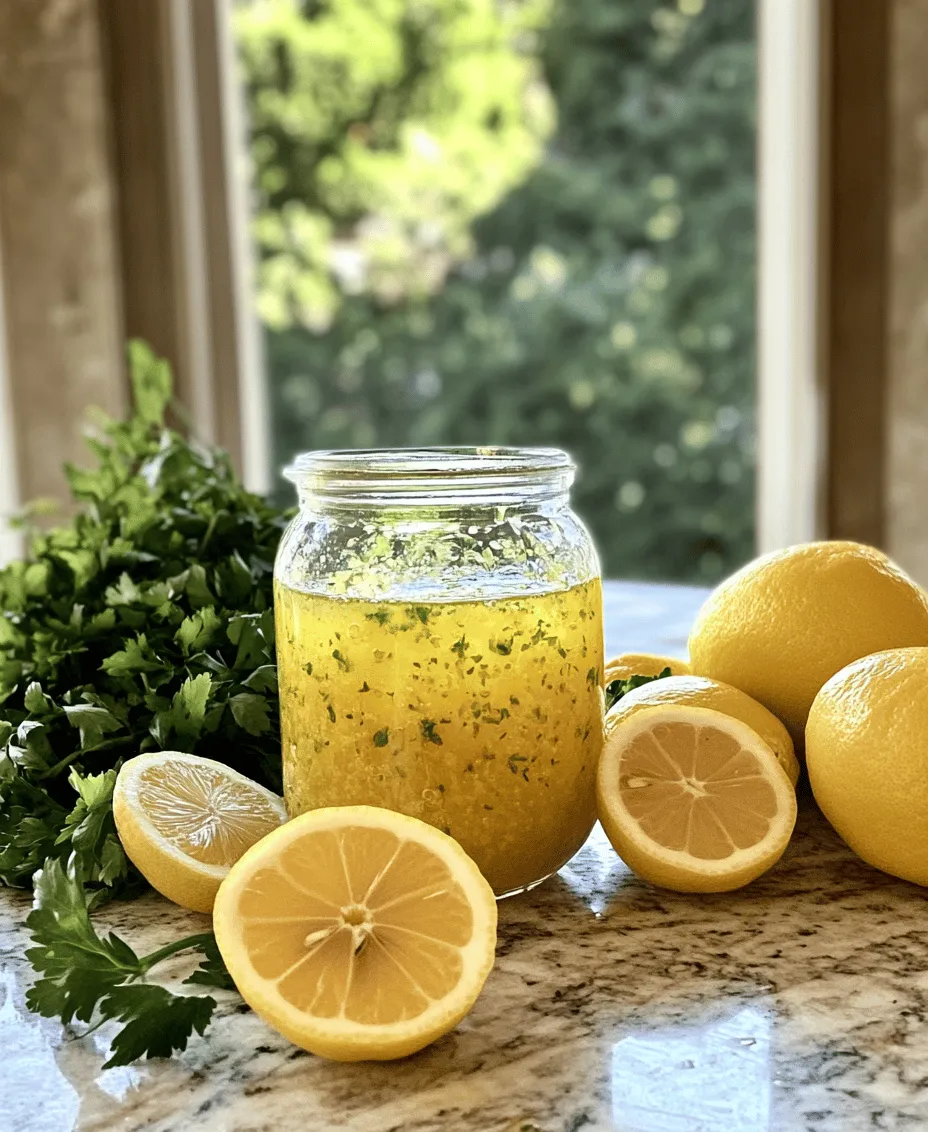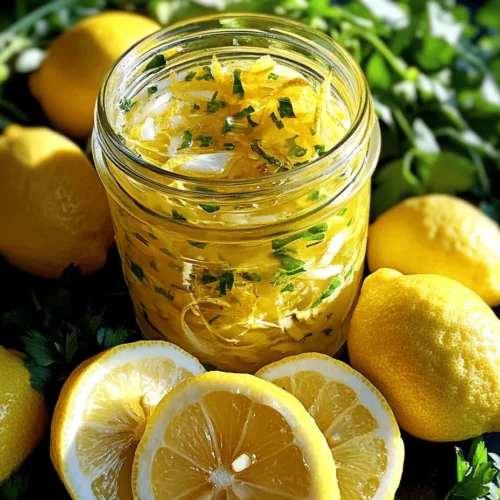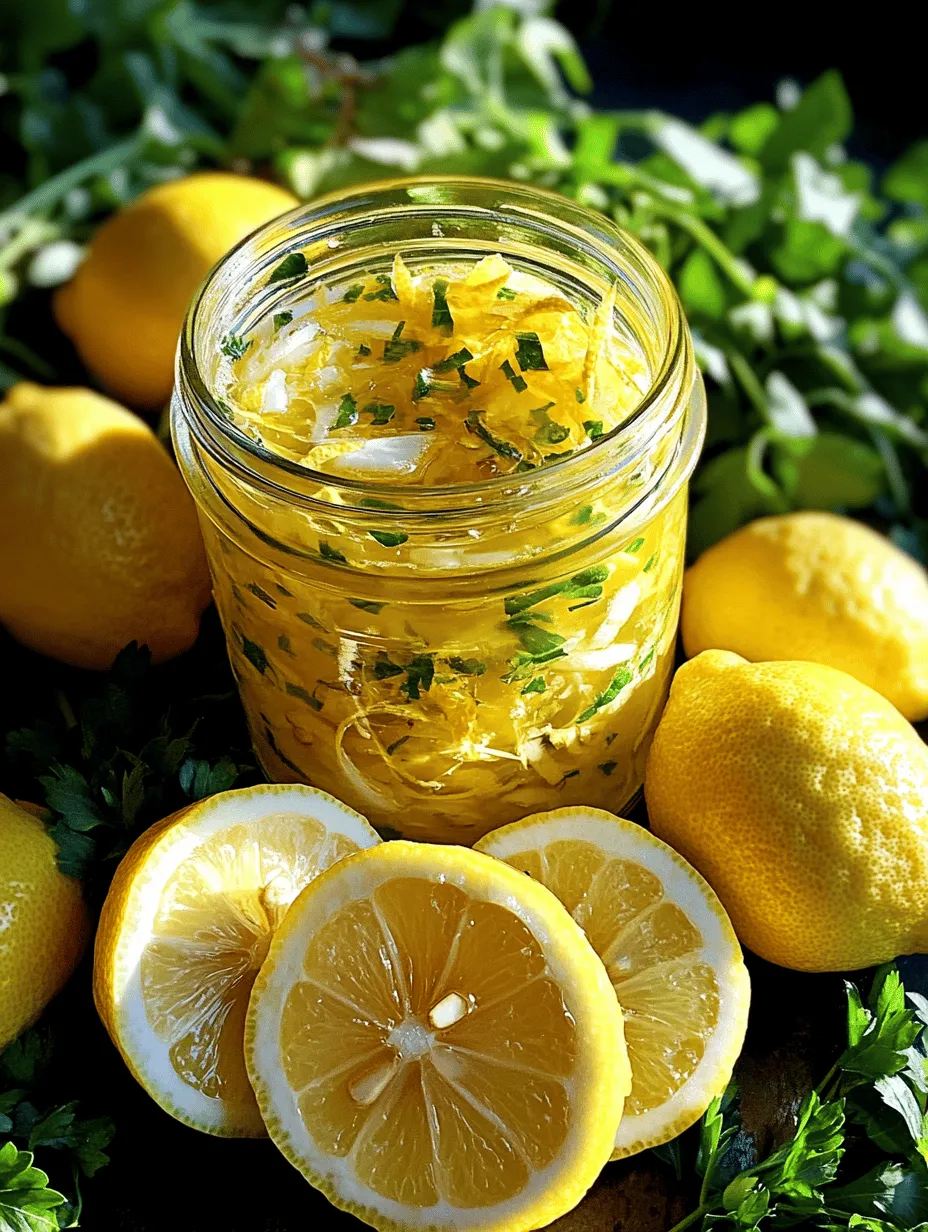Introduction
Dressings play a crucial role in elevating the flavors of salads and various dishes, transforming simple ingredients into memorable meals. A well-crafted dressing can enhance the freshness of greens, add depth to grains, and create a delightful contrast that brings dishes to life. Among the myriad of dressing options available, lemon vinaigrette stands out as a vibrant and versatile choice. Its zesty flavor profile not only invigorates salads but also serves as a perfect complement to a wide array of dishes.
Lemon vinaigrette is known for its refreshing taste, making it a fantastic addition to summer salads, grilled vegetables, or even as a marinade for meats. This simple yet flavorful dressing is made with just a few key ingredients, making it easy to whip up at home. What’s more, it appeals to various dietary preferences, including vegan and gluten-free diets, making it a staple for health-conscious eaters.
In addition to its delightful taste, lemon vinaigrette offers numerous health benefits. The vibrant lemon juice is rich in vitamin C and antioxidants, while the extra virgin olive oil provides healthy fats that are essential for heart health. This dressing not only enhances the flavor of your meals but also contributes to a balanced diet. In this article, we will delve into the various ingredients that make up this zesty dressing, explore its versatility across different dishes, and provide you with a step-by-step guide to creating your own refreshing lemon vinaigrette at home.
Understanding the Ingredients
Fresh Lemon Juice
When it comes to making a truly refreshing lemon vinaigrette, using fresh lemon juice is paramount. Freshly squeezed lemon juice captures the vibrant, tangy essence of the fruit, providing a bright flavor that bottled alternatives simply can’t match. Bottled lemon juice often contains preservatives and lacks the freshness that enhances the overall taste of your dressing. Additionally, fresh lemon juice is rich in vitamin C, which not only boosts your immune system but also adds a delicious tartness to your vinaigrette.
Extra Virgin Olive Oil
The choice of oil in your vinaigrette is just as important as the lemon juice. Extra virgin olive oil is the gold standard for dressings due to its rich flavor and numerous health benefits. It is packed with monounsaturated fats, which are linked to heart health, and contains antioxidants that can help reduce inflammation. When selecting olive oil, opt for high-quality extra virgin varieties to ensure the best flavor and health benefits. The oil serves as the base of the vinaigrette, providing a smooth texture that balances the acidity of the lemon juice.
Dijon Mustard
Dijon mustard plays a crucial role in emulsifying the vinaigrette, helping to combine the oil and lemon juice into a creamy consistency. Beyond its functional benefits, Dijon mustard adds a subtle depth of flavor with a mild heat that complements the acidity of the lemon. Additionally, it contains beneficial nutrients such as magnesium and selenium, making it a healthy addition to your dressing.
Honey vs. Maple Syrup
When it comes to sweetening your lemon vinaigrette, you have a choice between honey and maple syrup. Honey adds a lovely floral sweetness that pairs wonderfully with the tartness of lemon. However, for those following a vegan diet, maple syrup is an excellent alternative, providing a different but equally delicious flavor profile. Both options help to balance the acidity of the lemon juice, creating a harmonious dressing that enhances the overall taste of your dishes.
Garlic
Adding garlic to your lemon vinaigrette introduces a robust flavor that elevates the dressing to another level. Garlic not only enhances the taste but also offers a myriad of health benefits, including anti-inflammatory properties and cardiovascular support. Whether you choose to use fresh minced garlic or garlic powder, it contributes a savory depth that enriches the overall profile of the vinaigrette.
Salt and Pepper
Salt and pepper are essential seasonings that play a significant role in enhancing the flavors of any dish, including your lemon vinaigrette. A pinch of salt helps to bring out the natural flavors of the ingredients, while freshly cracked black pepper adds a subtle warmth and complexity. Together, they create a well-rounded dressing that can elevate even the simplest of salads.
Lemon Zest
Incorporating lemon zest into your vinaigrette is a game-changer. The zest contains essential oils that are packed with flavor, providing an additional layer of lemony brightness. This aromatic component enhances the overall taste of the dressing, making it even more refreshing. Grating the zest from organic lemons ensures that you are not introducing any unwanted chemicals into your dressing while maximizing flavor.
Optional Fresh Herbs
For those looking to customize their lemon vinaigrette further, adding fresh herbs can elevate the dressing to new heights. Herbs such as basil, parsley, or dill can introduce fresh, aromatic flavors that complement the citrus notes beautifully. Each herb brings its own unique character, allowing you to tailor the vinaigrette to suit your personal taste preferences or the specific dish you are preparing.
The Versatility of Lemon Vinaigrette
The true beauty of lemon vinaigrette lies in its versatility. This dressing can complement a wide range of dishes, making it a staple in any kitchen. Here are some ideas on how to incorporate this zesty dressing into your meals:
Salads
Lemon vinaigrette pairs exceptionally well with a variety of salads. From classic green salads featuring mixed greens, cucumbers, and tomatoes to grain-based salads with quinoa, farro, or brown rice, the bright flavor of the vinaigrette enhances the freshness of the ingredients. It also works wonders on simple salads featuring roasted vegetables or leafy greens topped with nuts and seeds for added texture.
Grains
In addition to salads, lemon vinaigrette can serve as a tasty dressing for grain bowls. Whether you are crafting a quinoa salad with roasted vegetables or a hearty farro bowl topped with chickpeas and greens, a drizzle of lemon vinaigrette adds a burst of flavor that ties the dish together. The acidity cuts through the richness of the grains, creating a balanced and satisfying meal.
Marinades
Lemon vinaigrette is not just for salads; it also makes an excellent marinade for proteins and vegetables. The acid in the lemon juice helps to tenderize meats and infuse them with flavor. Marinate chicken, fish, or even tofu in lemon vinaigrette for at least 30 minutes before cooking to enhance the taste and ensure a juicy result. Additionally, tossing vegetables in the vinaigrette before grilling or roasting can add a delightful tanginess to your sides.
Dipping Sauces
Another creative way to use lemon vinaigrette is as a dipping sauce for appetizers. This zesty dressing can be served alongside fresh vegetables, pita chips, or even grilled shrimp for an extra burst of flavor. Its versatility ensures that it can be enjoyed in various forms, making it a dynamic addition to your culinary repertoire.
Step-by-Step Instructions for Making Lemon Vinaigrette
Creating your own lemon vinaigrette at home is a straightforward process that requires just a few minutes and minimal effort. By following these simple steps, you can whip up a fresh batch of this delightful dressing that will elevate your meals.
1. Gather Your Ingredients: Start by assembling all the necessary ingredients, including fresh lemon juice, extra virgin olive oil, Dijon mustard, honey or maple syrup, minced garlic, salt, pepper, lemon zest, and any optional fresh herbs you choose to incorporate.
2. Juice the Lemons: Squeeze the juice from fresh lemons into a measuring cup, ensuring you remove any seeds. You will typically need about 2-3 lemons to yield ¼ cup of juice, but adjust according to your taste preferences.
3. Combine the Ingredients: In a mixing bowl, whisk together the lemon juice, Dijon mustard, and honey or maple syrup until well combined.
4. Add Olive Oil: Gradually pour in the extra virgin olive oil while continuously whisking. This process helps to emulsify the vinaigrette, creating a smooth and cohesive dressing.
5. Season to Taste: Stir in the minced garlic, salt, pepper, and lemon zest. Taste the vinaigrette and adjust the seasoning as needed, adding more salt, pepper, or sweetness according to your preference.
6. Incorporate Fresh Herbs (Optional): If you wish to add fresh herbs, finely chop them and mix them into the dressing at this stage.
7. Store or Serve: If you’re not using the vinaigrette immediately, transfer it to a clean jar or airtight container and store it in the refrigerator. Give it a good shake before serving, as the ingredients may separate over time.
By following these steps, you will create a refreshing lemon vinaigrette dressing that can enhance your meals and impress your family and friends. Whether drizzled over a crisp salad or used as a marinade, this dressing is sure to become a favorite in your culinary toolkit. Stay tuned for more tips and variations to make the most of your lemon vinaigrette!

Detailed Breakdown of the Preparation Process
Creating a Refreshing Lemon Vinaigrette Dressing is not just about mixing ingredients; it’s a culinary process that enhances the flavor of your dishes. Here’s a detailed guide to ensure that you achieve the perfect balance and texture.
Whisking the Base Ingredients: Importance of Technique
To start, combine your base ingredients: fresh lemon juice, olive oil, Dijon mustard, and a pinch of salt. The technique you use for whisking is crucial. A whisk is ideal for this purpose as it introduces air into the mixture, aiding in emulsification. Begin by whisking the lemon juice and mustard together until they are fully combined. The mustard acts as an emulsifier, which helps to blend the oil and lemon juice more effectively. Gradually add the olive oil while continuously whisking. The goal here is to create a smooth and cohesive dressing that doesn’t separate.
Emulsification: Explanation of Why This Step is Crucial
Emulsification is the process of combining two liquids that typically don’t mix well, in this case, oil and vinegar or lemon juice. When you whisk the ingredients together, the oil droplets disperse in the vinegar or lemon juice, creating a stable mixture. This step is crucial for a few reasons:
1. Texture: A well-emulsified vinaigrette has a creamy and uniform texture, making it more pleasing to the palate.
2. Flavor Distribution: Emulsification ensures that all the flavors are evenly distributed throughout the dressing, so every bite of your salad is equally flavorful.
3. Stability: Proper emulsification helps the vinaigrette maintain its consistency longer, preventing separation.
If you notice your vinaigrette separating after a while, simply give it a quick whisk or shake before serving to re-emulsify.
Adjusting Flavors: Tips on Tasting and Modifying the Dressing
Once you’ve achieved a good emulsion, it’s essential to taste your vinaigrette. This is where you can adjust the flavors to suit your palate. Here are a few tips to guide you:
– Balance: If your vinaigrette is too tart, consider adding a touch of sweetener, such as honey or maple syrup. Conversely, if it’s too sweet, a bit more lemon juice or vinegar can help balance it out.
– Salt and Pepper: Seasoning is key. Start with a pinch of salt and freshly cracked black pepper, then taste. Adjust according to your preference.
– Herbs and Spices: Feel free to experiment with fresh herbs or spices at this stage. Adding a sprinkle of garlic powder, onion powder, or fresh herbs can elevate the flavor profile.
Importance of Letting the Dressing Rest: Explanation of Flavor Melding
Once you’ve fine-tuned the taste of your lemon vinaigrette, allow it to rest for at least 15-30 minutes before serving. This resting period is vital as it allows the flavors to meld together, creating a more harmonious dressing. The ingredients, particularly the herbs, need time to infuse their flavors into the oil and vinegar. For the best results, consider preparing the vinaigrette a few hours in advance or even the night before.
Storage and Shelf Life
Best Practices for Storing Lemon Vinaigrette
Proper storage is essential for maintaining the freshness and flavor of your homemade lemon vinaigrette. Here are some best practices:
– Use an Airtight Container: Store your vinaigrette in a clean, airtight jar or container. A mason jar is perfect for this, as it can be sealed tightly.
– Label and Date: If you’re making large batches, label your container with the date it was made. This will help you keep track of its freshness.
Information on How Long It Lasts in the Fridge
When stored properly, lemon vinaigrette can last in the refrigerator for up to one week. However, it’s best to consume it within 3-5 days for optimal flavor. As time passes, the acidity from the lemon juice can intensify, which may alter the taste of the dressing.
Tips for Using Leftover Dressing in Creative Ways
Don’t let any leftover vinaigrette go to waste! Here are some creative ways to utilize it:
– Marinade: Use it as a marinade for chicken, fish, or tofu. The acidity helps tenderize the protein while adding flavor.
– Grain Bowls: Drizzle it over grain bowls or roasted vegetables to enhance their taste.
– Dip: Serve it as a dipping sauce for fresh vegetable sticks or crusty bread.
Health Benefits of Lemon Vinaigrette
Nutritional Analysis of Key Ingredients
Lemon vinaigrette dressing is not only delicious but also packed with health benefits. Here’s a quick look at the nutritional benefits of its key ingredients:
– Lemon Juice: Rich in vitamin C, lemon juice supports the immune system and aids in digestion.
– Olive Oil: A source of healthy fats, olive oil is known for its anti-inflammatory properties and heart health benefits.
– Dijon Mustard: Low in calories and fat, mustard adds flavor without adding significant calories.
Discussion on the Benefits of Using Fresh Ingredients in Homemade Dressings
Using fresh ingredients in homemade dressings provides numerous advantages over store-bought varieties. Here are a few:
– No Preservatives: Homemade dressings are free from preservatives and artificial ingredients, making them a healthier choice.
– Customization: You can tailor the flavors to your liking, adjusting sweetness, acidity, and seasoning based on your preferences.
– Nutrient-Rich: Fresh ingredients retain more of their nutritional value, ensuring that you gain the maximum health benefits.
Comparison of Homemade vs. Store-Bought Dressings in Terms of Health and Flavor
When comparing homemade lemon vinaigrette to store-bought options, the differences in health and flavor are striking:
1. Flavor: Homemade dressings typically offer a fresher, more vibrant taste compared to the often muted flavors of commercial dressings.
2. Ingredients: Store-bought dressings often contain added sugars, preservatives, and unhealthy fats, while homemade versions allow you to control what goes into your dressing.
3. Nutritional Value: Homemade dressings are more likely to be nutrient-dense since you can choose high-quality ingredients.
Creative Variations of Lemon Vinaigrette
Suggestions for Flavor Twists
While the classic lemon vinaigrette is a staple, there are countless ways to put a twist on the recipe. Here are some creative variations to try:
– Adding Different Citrus Juices: Experiment with other citrus juices such as lime or orange to create a different flavor profile. Lime adds a zesty kick, while orange offers sweetness.
– Experimenting with Different Herbs: Fresh herbs can drastically change the flavor of your vinaigrette. Consider adding cilantro for a fresh, vibrant taste or dill for a more earthy flavor.
– Incorporating Spices or Other Condiments: For a bit of heat, try adding red pepper flakes or a dash of hot sauce. Alternatively, a splash of balsamic vinegar can add depth and complexity to the dressing.
Conclusion
In summary, the Refreshing Lemon Vinaigrette Dressing is a versatile and healthful addition to any kitchen. Its vibrant flavor not only enhances salads but can also elevate a variety of dishes, from grilled meats to roasted vegetables. By making your dressing at home, you can tailor it to your taste preferences while ensuring that you are using fresh, wholesome ingredients.
I encourage you to experiment with the base recipe, adjusting flavors and trying out creative variations. Homemade dressings like this one play a crucial role in a healthy diet, allowing for culinary creativity and the enjoyment of fresh flavors. So grab your whisk, gather your ingredients, and indulge in the art of dressing making!



